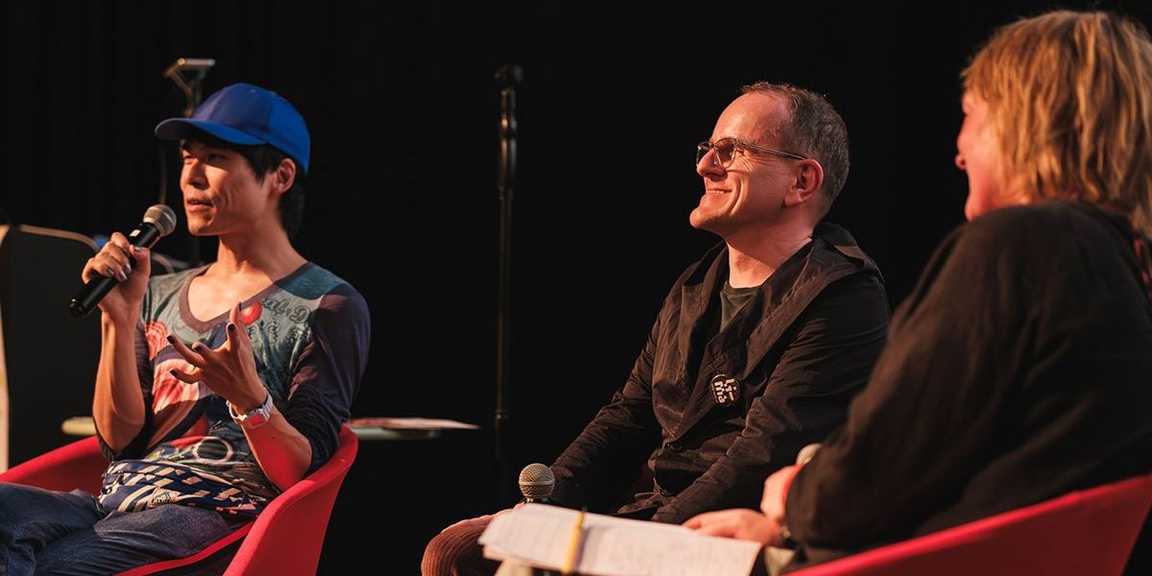
On Performance
On performance as framework and artistic method
This talk explored the concept of performance and its relationship to art and conservation from two distinct perspectives. Dragan Espenschied, Preservation Director at Rhizome, examined how performance can be a valuable framework in art conservation practices, while Naoto Hieda, artist and researcher at Tallinn University, delved into the role of performance in their own artistic process.
Author: Olwen Collins, Film Studies MA student at the University of Amsterdam
Dragan Espenschied: Six Types of Performativity
Dragan Espenschied's inquiry into the usefulness of performativity in his own work, particularly in relation to symbol manipulation — something computers inherently do — led him to reflect on how ideas of performance can be applied to digital art preservation. As the Preservation Director at Rhizome, an online museum-like organisation specialising in software and net art, he has spent the last decade leading preservation efforts. From his perspective, preservation is primarily an economic challenge. His presentation posed the question: how do artworks “perform” within a collection? To delve into this, Espenschied presented six ways that artists, museums, technicians, computers, and conservators interact with performance, illustrating each with examples that showcase the ways performance influences and shapes new media artworks in a collection.
Artist performs being an artist
Using the example of Dutch avant-garde artist Karel Appel, we see how he animatedly performs his role as a painter. The question arises: how do artists make sure their practice is recognized as artistic in the digital sphere, and how important is that for preservation?
Artist performs the artwork
Amalia Ulman’s 2014 performance Excellences & Perfections involved the artist playing the role of a young, aspirational influencer on Instagram. Whereas traditional performances use the body as a medium some of which might be symbolically represented through dance notation, the medium of an online performace is closely tied to a particular technical and cultural environment and might not make sense to repear.
Computer performs the artwork
Illustrated by Olaf Val’s 2006 work Pong Folie, computers can also be the artwork, as well as perform it. This shifts the focus of preservation, suggesting a more faithful reproduction of computer performance is necessary.
Institution performs an object being art
Espenschied cites art historian Wolfgang Ulrich, who discusses how some artists purposefully write difficult installation instructions for their work. In this context, the artist's intention can become a preservation challenge, increasing the total cost of ownership (TCO) of an artwork. The role of the institution in interpreting and installing the artwork is crucial in preserving the artist’s original vision, but should not solely rely on information from the artist.
Technicians perform artwork setup
Academic Pip Laurenson argues that when technicians set up a time based media artwork, new media art is the closest to performance. With computer-based works, if a piece isn't shown, it's not really ‘there’. This is different from internet art, which must always be accessible. A record of the setup process is invaluable in understanding the artwork’s presence, especially in digital contexts.
Conservator performs preservation actions
Art historians, programmers, and conservators also perform roles in the preservation process. What decisions they make, such as which restoration methods to apply, are influenced by their specific perspectives and expertise. People are infrastructure also, and their choices significantly shape conservation practices. Espenschied states: Every preservation action should move the work closer to an institutions infrastructure and processes.

Dragan Espenschied. Transformation Digital Art 2025, 20 March 2025. Photo by Alex Heuvink
Naoto Hieda: Digital Performance and Personal Narrative
Naoto Hieda’s talk focused on the intersection of digital media, performance and personal narrative in their work. Drawing on their Japanese heritage, and experiences living in Canada, Germany, and Estonia, the artist explored how social media platforms like Tumblr and digital artefacts (photos, videos and websites) shape their art practice. This is reflected in their website, soup.glitches.me, which serves as an ethnographic and autobiographical archive. They emphasised the blending of online and offline spaces, using tools like projections, iPads, and QR codes to create an interactive and immersive experience for the audience.
The presentation itself was a live performance that unfolded across many screens. A live webcam was set up above Naoto's desktop, capturing both their physical space and their digital interactions, as they flicked through photographs, text messages, and cards.
Performance as Practice
Central to Hieda’s artistic practice is the blending of physical dance with digital tools, creating a hybrid form of performance that challenges traditional boundaries. One key aspect of their work is the use of hand-drawn cards, which represent characters, concepts, and ideas. These cards serve as ideation tools for choreography and improvisation. By randomly shuffling and selecting the cards, Naoto's process rejects hierarchical, master-apprentice models of dance-making, instead advocating for a more collaborative and inclusive approach that draws on rhizomatic structures. The artist aims to empower others to explore and create dance through both physical and digital mediums, questioning how traditional dance practices can be expanded in the digital age.

Naoto Hieda, Transformation Digital Aart 2025, 20 March. Photo by Alex Heuvink






